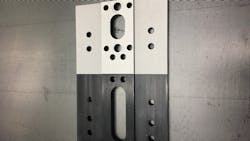A 'bright' idea? How lasers can be used for surface prep in remanufacturing and repair
In vehicle remanufacturing, core products like engines must be returned to essentially new condition in both quality and performance through a controlled, reproducible, sustainable process. The process typically involves disassembly, inspection, and replacing unsalvageable parts. In the remanufacturing process, removing grease, residue, contaminants, corrosion, and old coatings before applying a new coating is often important to assure proper adhesion. By ensuring the items are cleaned down to bare metal, remanufacturers and repair shops can avoid costly warranty issues that otherwise result when corrosion and contaminants cause performance issues and coatings peel, flake, bubble, or fail prematurely.
Unfortunately, the traditional techniques used for this purpose – such as abrasive media blasting, dry ice blasting, and chemical stripping – are messy and require expensive consumables, as well as substantial time for preparation and cleanup. These methods are also drawing scrutiny from regulators like the EPA and OSHA since they can pose risks to the environment and applicators.
Today, a more effective alternative is utilizing industrial-grade, precision laser-based systems that can remove residues, contaminants, paint, and rust with a high-energy laser beam that leaves the substrate unaffected. Preparation and cleanup time are minimal, and the low-maintenance equipment can last decades.
According to Vincent Galiardi, owner of Galiardi Laser Clean, a surface cleaning operator based in St. Charles County, Missouri, many people are surprised to learn that clean technology lasers are the most cost-effective, efficient, and safest method of vehicle component surface preparation.
“Many people are unfamiliar with the use of lasers to pretreat metal surfaces,” Galiardi said. “When I do a demonstration, at first the people in attendance are skeptical. But after I use the laser to treat a small area, everyone starts talking and getting excited. By the end, when I let them try the equipment, everyone is having a good time and saying how great the laser works.”
Laser systems can be integrated into automated inline processing lines, or technicians can use mobile handheld units. With significant advantages in safety and efficiency, laser cleaning is poised to disrupt the surface pre-treatment market for vehicle remanufacturers.
Resolving conventional cleaning limitations
In vehicle remanufacturing and repair, sandblasting, dry ice-blasting, or chemical stripping are traditionally used as industrial cleaning processes to pretreat metal surfaces but have various limitations.
Sandblasting
Abrasive sandblasting involves forcefully projecting a stream of abrasive particles onto a surface, usually with compressed air or steam. The silica sand used in abrasive blasting typically fractures into fine particles and becomes airborne, which can cause serious or fatal respiratory disease.
“When sand or any other media is used to knock off particles from a substrate, there is always a byproduct that has the potential to become airborne and inhaled,” Galiardi said. “Besides the sand, this could be the particles you’re removing – the coatings, plating, anodizing, corrosion, and even lead paint.”
Sandblasting also is time-consuming to clean up since the sand essentially scatters everywhere, even though it is usually considered a “fast” cleaning method.
Dry ice blasting
With dry ice blasting, dry ice pellets are used as the abrasive. The challenge is that dry ice blasting is often not abrasive enough to sufficiently remove paint or corrosion from the surface of metals. Since dry ice is an expensive consumable, the costs can escalate when cleaning metal surfaces in higher volumes.
Chemical stripping
With chemical stripping, harsh, even toxic chemicals are used to strip metal-based objects of paint, rust, and other contaminants to bare metal. However, for operators, exposure to corrosive acids and noxious chemical fumes is inherently dangerous. The process can also be time-consuming to prepare the proper chemical bath, achieve the required level of cleaning, and dispose of the waste. In addition, disposing of toxic chemicals is costly and closely regulated by agencies like OSHA and the EPA.
Safe, effective laser-cleaning
Laser-based systems have significant advantages over these traditional methods, including ease of use in which an operator simply points and clicks a high-energy laser beam at the surface. The substrate is not affected by the laser, and the systems do not create any mess or byproducts. The approach is eco-friendly, energy-efficient, and completes the job in half the time of traditional methods when preparation and cleanup are considered.
“In our experience, laser cleaning is as fast at removing rust or old coatings as other methods, but without the same amount of cleanup,” Galiardi said. “When we treat a surface with lasers, any fumes or dislodged particulates are extracted into a HEPA filter and the job is done. There is no media (sand, dry ice, chemicals) to replenish or clean up.”
Galiardi Laser Clean uses laser systems made by Orlando, Florida-based Laser Photonics, a leading provider of patented industrial grade CleanTech laser systems for cleaning and surface conditioning. The American-made systems function either as mobile standalone units or can be integrated into production lines.
The laser systems are available in portable and stationary models ranging from 50 to 3,000-watts (a 4,000-watt version is in development) with chamber sizes from 3’ x 3’ in size to 6’ x 12’. The systems can also be installed in remanufacturing lines in cabinets or operated by a robotic arm.
Galiardi says that laser pre-treatment of metal surfaces can be used to streamline various remanufacturing processes. Corrosion, for example, can begin to accumulate within a very short time on remanufactured parts, depending on the material and environmental conditions, and should be removed prior to coating.
For one major auto remanufacturer, Galiardi Laser Clean was asked to remove rust from conveying system components used to transport cars through the process. The components were corroded due to being left outside during a 6-month delay in the project. When it was time to install the items, the provider wanted to first treat the surfaces and return the components to a “like new” appearance.
In another example, Galiardi was asked to remove rust from over 400 transmissions in a couple of days. The laser systems are particularly effective when reaching into tight spaces that are hard to reach by hand. By masking the area to protect vulnerable parts, the laser can be applied without affecting the rest of the assembled product.
“No other parts (of the transmission) had to be removed and nothing had to be cleaned afterwards,” he said.
Galiardi’s company also utilized the laser system to remove cleaning oils from truck chassis. “We used the laser to remove the oil right before painting so it was a bare metal object going with nothing on it that would affect the coating,” he said.
With clean laser technology, there is now an environmentally friendly alternative to abrasive blasting and chemical stripping for surface pretreatment. The approach is safer for operators and highly adaptable to a wide range of vehicle remanufacturing and repair applications.
“As people become more aware of laser-based systems and compare them to traditional methods, they need to factor in prep and cleanup time, which can significantly impact project cost. When the improved operator safety, equipment longevity, and lower maintenance of laser systems are also considered, the clean laser technology has a much higher ROI,” Galiardi said.
The longevity of low-maintenance laser systems further adds to their value, increasing ROI, and making replacement unnecessary for decades.
“CleanTech laser systems can last for 50,000 to 100,000 hours. That’s many decades working eight-hour days. After purchase, there’s virtually no maintenance necessary,” he concluded.



